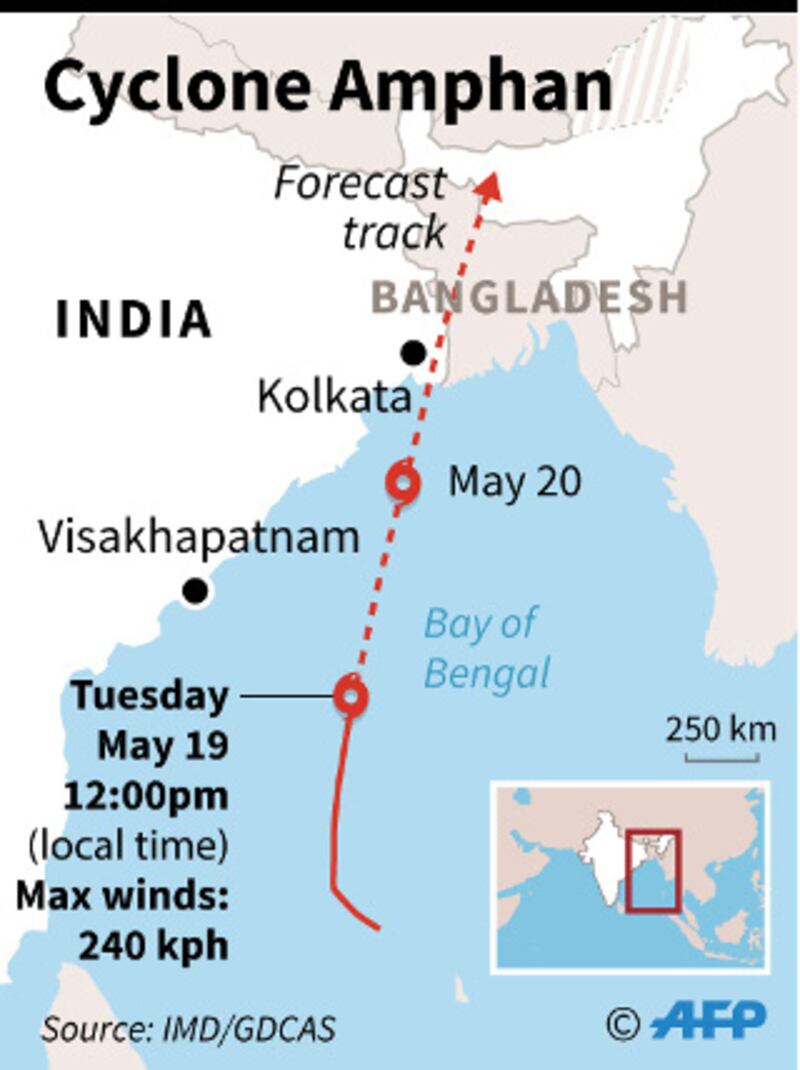Bangladeshi authorities were rushing some 2.2 million people to shelter as Cyclone Amphan churned northward in the Bay of Bengal, with a projected landfall near the India-Bangladesh border late Wednesday.
Amphan will be packing sustained winds around 120 kph (75 mph) when it reaches the coast, according to the U.S. Navy’s Joint Typhoon Warning Center, adding new worries to a nation already contending with steep increases in coronavirus infections daily.
“Amphan will hit the Southwestern Satkhira-Khulna region … It is likely to hit the Bangladesh coast by Wednesday evening,” Shamsuddin Ahmed, director of the Bangladesh Meteorological Department under the Ministry of Defense, told BenarNews.
Authorities said they had begun moving vulnerable families in coastal districts to safe spots, even while trying to maintain social distancing in shelters.
“Our target is to bring about 2.2 million people to cyclone shelters,” Dr. Enamur Rahman, state minister for disaster management ministry, told BenarNews Tuesday night. “By 8 p.m., 1.8 million people have been taken to different cyclone shelters.”
Disaster experts said they feared evacuees could be vulnerable to COVID-19 even as they took shelter from the fury of the storm.
“For cyclone Fani, we sheltered 2 million people in over 5,500 cyclone shelters. But due to the coronavirus vulnerability, we have readied 12,078 cyclone shelters so people could maintain social distancing,” Rahman said.
Bangladeshis are accustomed to taking shelter from cyclones. The most recent, Bulbul, hit in November 2019. Seven months earlier, Fani killed 17 people. A cyclone on April 29, 1991 killed 150,000 people.
“Cyclones are not new to Bangladesh. But this year’s Amphan has created a double danger as we have been dealing with the coronavirus pandemic,” Abdul Latif, an independent disaster analyst, told BenarNews. “We have never seen such a natural disaster amid a health disaster.”
The evacuees’ focus will be on the storm, he said.
“So the coronavirus may spread within the cyclone shelters,” Latif said.
Cyclone will hit island housing Rohingya
Rahman said Rohingya camps in southeastern Bangladesh were likely to avoid the brunt of the storm. “But with the help of U.N. agencies, NGOs and volunteers, we have kept adequate preparations to relocate vulnerable Rohingya, if necessary, to cyclone shelters,” he said.
Bhashan Char, a low-lying island in the Bay of Bengal housing a few hundred refugees, would not be spared, Rahman said, insisting it was safe.
“Bhashan Char is likely to be hit. But there are over 120 cyclone shelters there. This is a completely safe island,” Rahman said.
Authorities took about 310 Rohingya to Bhashan Char after rescuing them from smuggling boats in the Bay of Bengal earlier this month, citing fears they could spread coronavirus in densely packed refugee camps of Cox’s Bazar where close to 1 million Rohingya refugees live.
Last week, United Nations Secretary-General António Guterres urged Bangladesh to bring the refugees to the mainland once their quarantine was over.
“I trust that they too, will benefit from the humanitarian services offered to the Rohingya in Bangladesh and that, at the end of their quarantine period … they will be allowed to rejoin their families in Cox’s Bazar,” said a letter from Guterres to the foreign minister of Bangladesh.
A.K. Abdul Momen, Bangladesh’s top diplomat, said his government had not yet taken a decision on the matter.
“We have yet to decide about it. We will do what we think is best,” Momen told BenarNews on Monday. “We do understand what is good and what is bad for the Rohingya.
“There is a unanimous U.N. resolution that stipulates it is the shared responsibility of all states when some people are rescued at sea, but the U.N. always turns to Bangladesh when Rohingya are in trouble or adrift in the sea, as if there is no other country in the Bay of Bengal region,” he added.
Rohingya on the mainland expressed fears about Amphan’s potential impact on the sprawling refugee settlements.
“When the cyclone makes landfall, there could be landslides. It will destroy houses and huts. It could kill many people,” Aung Myaing, a refugee in Kutupalong camp, told Radio Free Asia (RFA), a sister entity of BenarNews.
Mohammad Shamsu Douza, an additional refugee relief and repatriation commissioner, said officials met with their counterparts from U.N. relief agencies on Saturday and Monday to prepare for the storm.
“Already we have made preparations and kept volunteers on stand-by for any emergency situation,” he said.
COVID-19 toll increases
Meanwhile, Bangladesh continued to record steep increases in coronavirus cases, with the official death toll at 370 and the total number of infections at 25,212 as of Tuesday.
Dr. Abu Mohammad Toha, a health official at the office of refugee relief and repatriation, told BenarNews that four more Rohingya had been infected with COVID-19 since Monday, bringing the total number of Rohingya cases to nine – all in a camp in Ukhia, a sub-district of Cox’s Bazar.
“We have already isolated all nine Rohingya so that the virus cannot spread. Their family members have also been isolated from other Rohingya,” Mahbub Alam Talukder, the refugee relief and repatriation commissioner, told BenarNews.
Globally, more than 4.8 million have been infected, and at least 321,000 have died as of Tuesday, according to data compiled by disease experts at U.S.-based Johns Hopkins University.

